|
|
|
Sort Order |
|
|
|
Items / Page
|
|
|
|
|
|
|
| Srl | Item |
| 1 |
ID:
098878
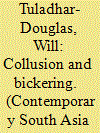

|
|
|
|
|
| Publication |
2010.
|
| Summary/Abstract |
By considering bickering, gossip and similar artful kinds of talk that reproduce social categories in a central Himalayan town, it is possible to see that participants in such talk collude in constructing a social landscape that grounds the relational distinctions foregrounded in those conversations. Following on from discussions that suggest anthropology of the environment must consider other social relations, here it is proposed that the environment is inescapably part of relational social distinctions. Collusion in the production of such shared landscapes, it is argued, is a key aspect of achieving ordinary life and, in certain contexts, can become the basis for resistance to the imposition of unwanted categorical distinctions.
|
|
|
|
|
|
|
|
|
|
|
|
|
|
|
|
| 2 |
ID:
098877
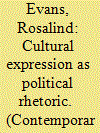

|
|
|
|
|
| Publication |
2010.
|
| Summary/Abstract |
This article explores the experiences of young Bhutanese refugees growing up in long-term camps in eastern Nepal. It focuses on a period of political crisis in the camps in 2006-2007, when community members' opinions clashed over long-term solutions to the refugee situation. The article examines the use of cultural expression - song, poetry, dance, art and drama - as a form of political rhetoric employed to inspire collective action for social change. These methods are used both by international agencies engaging children in community-based advocacy for improved children's rights and by revolutionary political groups building support for armed struggle to enable the refugees' return to Bhutan. The article considers how various actors use cultural expression to transform individuals' consciousness and build collective identities, and questions to what political ends these identities are put.
|
|
|
|
|
|
|
|
|
|
|
|
|
|
|
|
| 3 |
ID:
098879
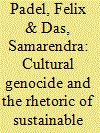

|
|
|
|
|
| Publication |
2010.
|
| Summary/Abstract |
In mining projects and metal factories proliferating in tribal areas of eastern central India, a gross disparity is evident between the dispossession and violence experienced by tribal communities on the one hand, and the rhetoric of 'sustainable development' put out by mining companies through public relations companies and the media on the other. While a large section of India's middle classes accept and identify with this rhetoric, grassroots movements of resistance to industrial displacement are gathering strength. 'Sustainable mining' is a concept promoted by mining companies through the International Council on Mining and Metals through its Mining, Minerals and Sustainable Development report. Yet long-term sustainability is the essence of the tribal communities being dispossessed of their land and resources, and a 'reality gap' exists between the rhetoric of development and events on the ground. Poverty is increasing, and 'cultural genocide' is a fitting description of the displacement process experienced by hundreds of tribal communities, while the war against the Maoists is in many ways a classic 'resource war'.
|
|
|
|
|
|
|
|
|
|
|
|
|
|
|
|
| 4 |
ID:
098875
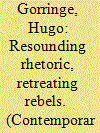

|
|
|
|
|
| Publication |
2010.
|
| Summary/Abstract |
Oratory is an important aspect of Tamil culture, and people delight in the poetic flourishes of podium speakers. It is no surprise, therefore, that the leader of the largest Dalit movement in Tamilnadu is revered for linguistic prowess. The significance of movement utterances, however, extends beyond content and style. In recent decades, Dalit rhetoric has increasingly promised to 'hit back'. Although these perorations have been credited with instilling a sense of pride, courage and assertiveness into previously submissive social groups, such analyses often take movement oratory at face value. A more contextualised reading of such speech-acts reveals that whilst 'hitting back' can restore a sense of pride, it can also undermine Dalit agency by reinforcing their characterisation as victims. In a vicious circle, radical rhetoric stokes the fires of caste conflict, which then inspires further tales of victimisation. Celebrations of Dalit lyricism, therefore, need to be tempered by an appreciation of its context and consequences.
|
|
|
|
|
|
|
|
|
|
|
|
|
|
|
|
| 5 |
ID:
098874
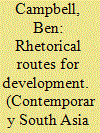

|
|
|
|
|
| Publication |
2010.
|
| Summary/Abstract |
Rhetoric is adopted in this paper as a lens to look at the claims made by a road-building project in a region of Nepal characterised by 'remoteness' and underdevelopment. The notion that the road connecting to the infrastructure on the Chinese side of the border will improve the livelihoods of the poor on the Nepalese side is discussed with a range of people in different villages along the proposed route. By attending to vernacular articulations of poverty and globalisation, it is argued that a method of rhetorical sensibility offers greater ethnographic value for understanding development's entanglements with social life than does the notion of discourse.
|
|
|
|
|
|
|
|
|
|
|
|
|
|
|
|
| 6 |
ID:
098873


|
|
|
|
|
| Publication |
2010.
|
| Summary/Abstract |
The paper considers the trope of 'persons-in-parivaara', persons in a retinue, as a rhetorical and social form in South Asia, using Digambar Jain examples, mostly from Maharashtra. As a social form, persons-in-parivaara evokes familiar themes, especially hierarchy in relationships, the vote bank, and Mattison Mines' notion of the 'big man'. The paper shows how the persons-in-parivaara trope is used in a wide variety of media and genres, including personal curriculum vitae, adversarial journalism, graphic illustrations, photography as displayed or published, and the arrangement of persons in space during a concerted action. In this respect, the trope demonstrates that social forms, amounting to what has been called 'culture', are essentially rhetorical; that is, are used to achieve some project. Tropes are never certain of success, but are rather fragile and subject to failure as well as success.
|
|
|
|
|
|
|
|
|
|
|
|
|
|
|
|
| 7 |
ID:
098876
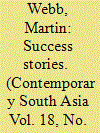

|
|
|
|
|
| Publication |
2010.
|
| Summary/Abstract |
This article will look at the use of 'success stories' by groups involved in the Right to Information movement in north India. Success stories are narratives tailored by activists to promote active citizenship and to persuade publics that Right to Information legislation can improve accountability in everyday bureaucratic processes by balancing the power relationship between the citizen and the public servant. Success stories might be reproduced as first-hand, text or audio-visual accounts, and the Internet has enabled wide reproduction and dissemination of some narratives in particular. As rhetorical devices, success stories play an important role in activist groups' attempts to frame citizenship and bureaucratic accountability but also have a role in promoting movement cohesion and continuity. Success stories presented at conferences by authentic grassroots activists help to show influential movement sympathisers and policy-makers that the movement is socially diverse and that ordinary people are participating. The conscious use of rhetoric is part of building a sense of belonging to particular groups or to the wider movement. An ethnographic focus on the production, reproduction and performance of success stories reveals the extent to which concern over representation is central to activist practice and identity.
|
|
|
|
|
|
|
|
|
|
|
|
|
|
|
|
|
|
|
|
|